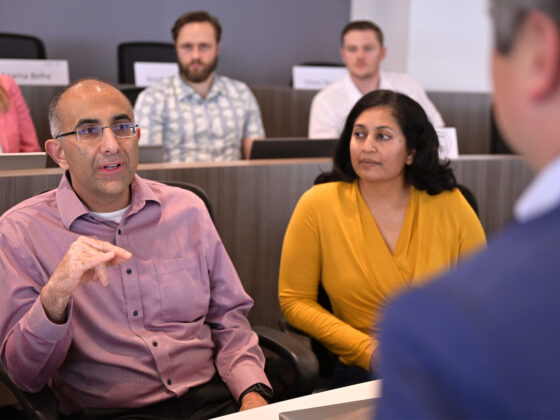Darden is known for its transformational learning experiences for individual leaders. But, how does Darden help ensure the learning is relevant to their organizations’ strategic goals? Lisa Cannell (MBA ’17), Managing Director for Client Solutions, shares her perspective as a former HR leader and Darden MBA grad who now works with corporate and association clients who partner with Darden on leadership development.
Seasoned HR professionals understand that learning is not just a one-time event; it’s a continuous journey. It’s about equipping our employees with the skills and knowledge they need to excel in their roles, all while keeping a close eye on our organization’s bigger picture.
This is where the concept of learning architecture comes into play. Think of it as the blueprint for constructing a bridge between individual learning experiences and the broader organizational strategy. It’s our master plan for ensuring that every bit of learning within the company contributes directly to our goals.
Creating a robust learning architecture involves several key steps:
- Understand our company’s strategic objectives – What are we trying to achieve in the short term and the long term? What skills and competencies are critical to reaching these milestones? This deep understanding serves as the foundation upon which we build our learning architecture.
- Design learning experiences that align with these objectives – This is the fun part! It’s like crafting a tailor-made suit; each learning module, workshop, or seminar should fit perfectly into the bigger picture. We must identify the skills and knowledge our employees need to contribute effectively to our strategic goals.The beauty of a well-crafted learning architecture is that it doesn’t operate in isolation. It’s a dynamic system that adapts as our company evolves. We must regularly assess the effectiveness of our learning initiatives, gathering feedback and adjusting our plans accordingly.As a top business development provider, Darden Executive Education & Lifelong Learning is well equipped to help organizations with this process. We start by understanding your organizations’ business strategy. It will tell us what skills are needed to achieve your goals and drive both the capability assessment and talent development strategy.
- Construct the learning architecture – segment talent pools for the skills development and prioritize or identify the leadership competencies.
- Match the opportunities for learning to the needs – identify the specific programs or modules to build the learning journey for each group/cohort.
- Ground the learning in metrics tied to the business
Each of these steps is aligned with purpose, process and outcome achieved.

Why is all of this so important, you might ask? Well, it’s because a learning architecture ensures that every investment in employee development directly contributes to our company’s growth. It’s about aligning individual aspirations and achievements with the company’s strategic vision.
Creating a robust learning architecture is not just a nice-to-have; it’s a must-have in today’s rapidly changing business landscape. It’s the GPS that keeps our employees on the path to success, and it’s the key to ensuring that our learning experiences are in perfect harmony with our company strategy.
I welcome an opportunity to talk about the current learning architecture at your organization.
Connect with Lisa to discuss your organization’s development needs or learn more about our Solutions for Organizations.




